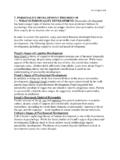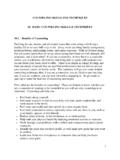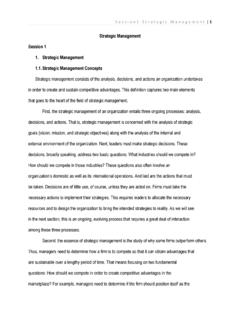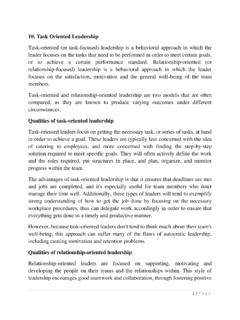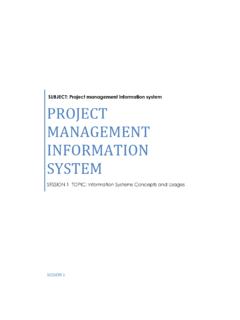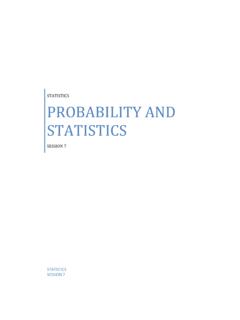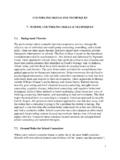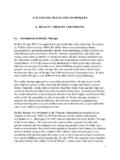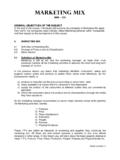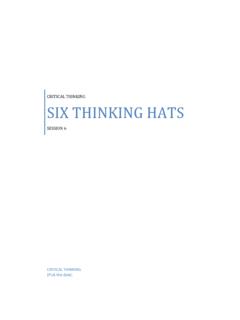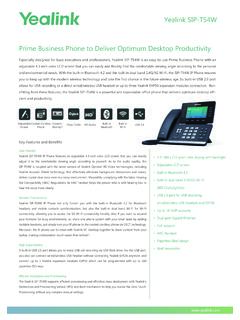Transcription of 7 Job Analysis - Job Description and Job Specification
1 SEC 7 Page 1 of 5. 7 Job Analysis - Job Description and Job Specification 1. Job Analysis is primary tool in personnel management. In this method, a personnel manager tries to gather, synthesize and implement the information available regarding the workforce in the concern. A personnel manager has to undertake job Analysis so as to put right man on right job. There are two outcomes of job Analysis : 1. Job Description 2. Job Specification The information collected under job Analysis is: 1. Nature of jobs required in a concern. 2. Nature/ size of organizational structure. 3. Type of people required to fit that structure. 4. The relationship of the job with other jobs in the concern. 5. Kind of qualifications and academic background required for jobs. 6. Provision of physical condition to support the activities of the concern.
2 For example- separate cabins for managers, special cabins for the supervisors, healthy condition for workers, adequate store room for store keeper. Advantages of Job Analysis 1. Job Analysis helps the personnel manager at the time of recruitment and selection of right man on right job. 2. It helps him to understand extent and scope of training required in that field. 3. It helps in evaluating the job in which the worth of the job has to be evaluated. 4. In those instances where smooth work force is required in concern. 5. When he has to avoid overlapping of authority- responsibility relationship so that distortion in chain of command doesn't exist. 6. It also helps to chalk out the compensation plans for the employees. 7. It also helps the personnel manager to undertake performance appraisal effectively in a concern. 2. Job Analysis is a process to identify and determine in detail the particular job duties and requirements and the relative importance of these duties for a given job.
3 Job Analysis is a process where judgments are made about data collected on a job. SEC 7 Page 2 of 5. The Job; not the person An important concept of Job Analysis is that the Analysis is conducted of the Job, not the person. While Job Analysis data may be collected from incumbents through interviews or questionnaires, the product of the Analysis is a Description or specifications of the job, not a Description of the person. Purpose of Job Analysis The purpose of Job Analysis is to establish and document the 'job relatedness' of employment procedures such as training, selection, compensation, and performance appraisal. Determining Training Needs Job Analysis can be used in training/"needs assessment" to identify or develop: training content assessment tests to measure effectiveness of training equipment to be used in delivering the training methods of training ( , small group, computer-based, video, ).
4 Compensation Job Analysis can be used in compensation to identify or determine: skill levels compensable job factors work environment ( , hazards; attention; physical effort). responsibilities ( , fiscal; supervisory). required level of education (indirectly related to salary level). Selection Procedures Job Analysis can be used in selection procedures to identify or develop: job duties that should be included in advertisements of vacant positions;. appropriate salary level for the position to help determine what salary should be offered to a candidate;. minimum requirements (education and/or experience) for screening applicants;. interview questions;. selection tests/instruments ( , written tests; oral tests; job simulations);. applicant appraisal/evaluation forms;. orientation materials for applicants/new hires SEC 7 Page 3 of 5.
5 Performance Review Job Analysis can be used in performance review to identify or develop: goals and objectives performance standards evaluation criteria length of probationary periods duties to be evaluated 3. Methods of Job Analysis A typical method of Job Analysis would be to give the incumbent a simple questionnaire to identify job duties, responsibilities, equipment used, work relationships, and work environment. The completed questionnaire would then be used to assist the Job Analyst who would then conduct an interview of the incumbent(s). A draft of the identified job duties, responsibilities, equipment, relationships, and work environment would be reviewed with the supervisor for accuracy. The Job Analyst would then prepare a job Description and/or job specifications. The method that you may use in Job Analysis will depend on practical concerns such as type of job, number of jobs, number of incumbents, and location of jobs.
6 Several methods exist that may be used individually or in combination. These include: review of job classification systems incumbent interviews supervisor interviews expert panels structured questionnaires task inventories check lists open-ended questionnaires observation incumbent work logs What Aspects of a Job Are Analyzed? Job Analysis should collect information on the following areas: SEC 7 Page 4 of 5. Duties and Tasks The basic unit of a job is the performance of specific tasks and duties. Information to be collected about these items may include: frequency, duration, effort, skill, complexity, equipment, standards, etc. Environment This may have a significant impact on the physical requirements to be able to perform a job. The work environment may include unpleasant conditions such as offensive odors and temperature extremes.
7 There may also be definite risks to the incumbent such as noxious fumes, radioactive substances, hostile and aggressive people, and dangerous explosives. Tools and Equipment Some duties and tasks are performed using specific equipment and tools. Equipment may include protective clothing. These items need to be specified in a Job Analysis . Relationships Supervision given and received. Relationships with internal or external people. Requirements The knowledge, skills, and abilities (KSA's) required to perform the job. While an incumbent may have higher KSA's than those required for the job, a Job Analysis typically only states the minimum requirements to perform the job. personnel manger carries Analysis in two ways: a. Job Description b. Job Specification JOB Description is an organized factual statement of job contents in the form of duties and responsibilities of a specific job.
8 The preparation of job Description is very important before a vacancy is advertised. It tells in brief the nature and type of job. This type of document is descriptive in nature and it constitutes all those facts which are related to a job such as : 1. Title/ Designation of job and location in the concern. 2. The nature of duties and operations to be performed in that job. 3. The nature of authority- responsibility relationships. 4. Necessary qualifications that is required for job. 5. Relationship of that job with other jobs in a concern. 6. The provision of physical and working condition or the work environment required in performance of that job. Advantages of Job Description SEC 7 Page 5 of 5. 7. It helps the supervisors in assigning work to the subordinates so that he can guide and monitor their performances. 8. It helps in recruitment and selection procedures.
9 9. It assists in manpower planning. is also helpful in performance appraisal. is helpful in job evaluation in order to decide about rate of remuneration for a specific job. also helps in chalking out training and development programs. JOB Specification is a statement which tells us minimum acceptable human qualities which helps to perform a job. Job Specification translates the job Description into human qualifications so that a job can be performed in a better manner. Job Specification helps in hiring an appropriate person for an appropriate position. The contents are : 1. Job title and designation 2. Educational qualifications for that title 3. Physical and other related attributes 4. Physique and mental health 5. Special attributes and abilities 6. Maturity and dependability 7. Relationship of that job with other jobs in a concern.
10 Advantages of Job Specification 8. It is helpful in preliminary screening in the selection procedure. 9. It helps in giving due justification to each job. also helps in designing training and development programs. helps the supervisors for counseling and monitoring performance of employees. helps in job evaluation. helps the management to take decisions regarding promotion, transfers and giving extra benefits to the employees. From the above advantages, we can justify the importance of job Analysis and its related products. Both job descriptions as well as job Specification are important for a personnel manager in personnel management function. Therefore, job Analysis is considered to be the primary tool of personnel management.
